The Evolution of Plant Mating Systems.
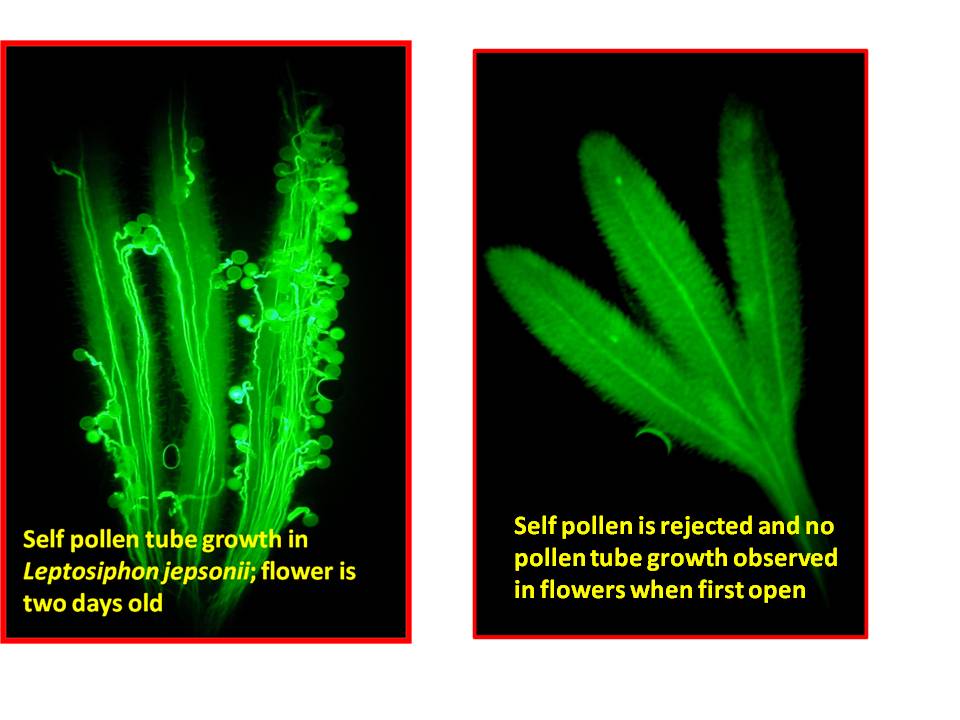 Evolution
of self-compatibility in Leptosiphon. We are interested
in the ecological and genetic factors that play a role in the evolution of
self-fertilization from self-incompatibility – a genetic mechanism that allows
a plant to recognize and reject its own pollen to promote
cross-fertilization. Our research has focused on Leptosiphon, a genus
of California annuals that exhibits remarkable variation in breeding system
traits. Leptosiphon
jepsonii has an unusual and variable breeding system that provides
us with a unique opportunity to study the breakdown of
self-incompatibility. The flowers of most L. jepsonii plants are initially
self-incompatible, becoming capable of selfing later in anthesis; other plants
are self-compatible when flowers first open. The frequency of these
different phenotypes ranges widely among populations, allowing us to explore
how outcrossing rate, inbreeding depression, reproductive assurance and other
parameters are correlated with variation in self-compatibility.
Interestingly, our crossing and selection studies show that different genes
control the timing of self-compatibility in different populations, suggesting
that there are multiple genetic pathways to the breakdown of
self-incompatibility. This project has been funded by NSF and has yielded
two Master's theses.
Evolution
of self-compatibility in Leptosiphon. We are interested
in the ecological and genetic factors that play a role in the evolution of
self-fertilization from self-incompatibility – a genetic mechanism that allows
a plant to recognize and reject its own pollen to promote
cross-fertilization. Our research has focused on Leptosiphon, a genus
of California annuals that exhibits remarkable variation in breeding system
traits. Leptosiphon
jepsonii has an unusual and variable breeding system that provides
us with a unique opportunity to study the breakdown of
self-incompatibility. The flowers of most L. jepsonii plants are initially
self-incompatible, becoming capable of selfing later in anthesis; other plants
are self-compatible when flowers first open. The frequency of these
different phenotypes ranges widely among populations, allowing us to explore
how outcrossing rate, inbreeding depression, reproductive assurance and other
parameters are correlated with variation in self-compatibility.
Interestingly, our crossing and selection studies show that different genes
control the timing of self-compatibility in different populations, suggesting
that there are multiple genetic pathways to the breakdown of
self-incompatibility. This project has been funded by NSF and has yielded
two Master's theses.
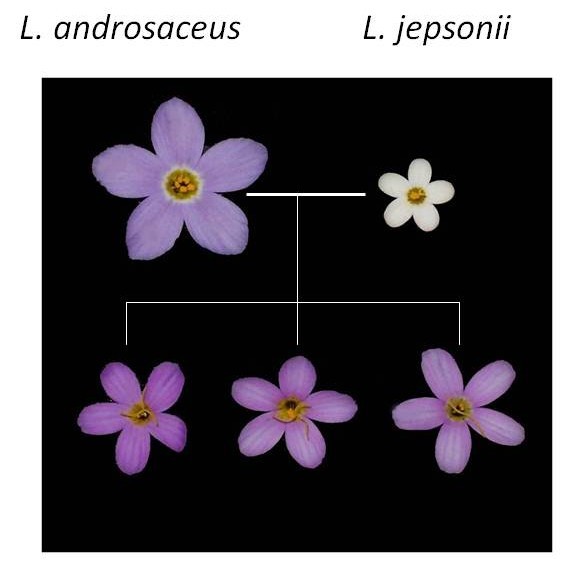
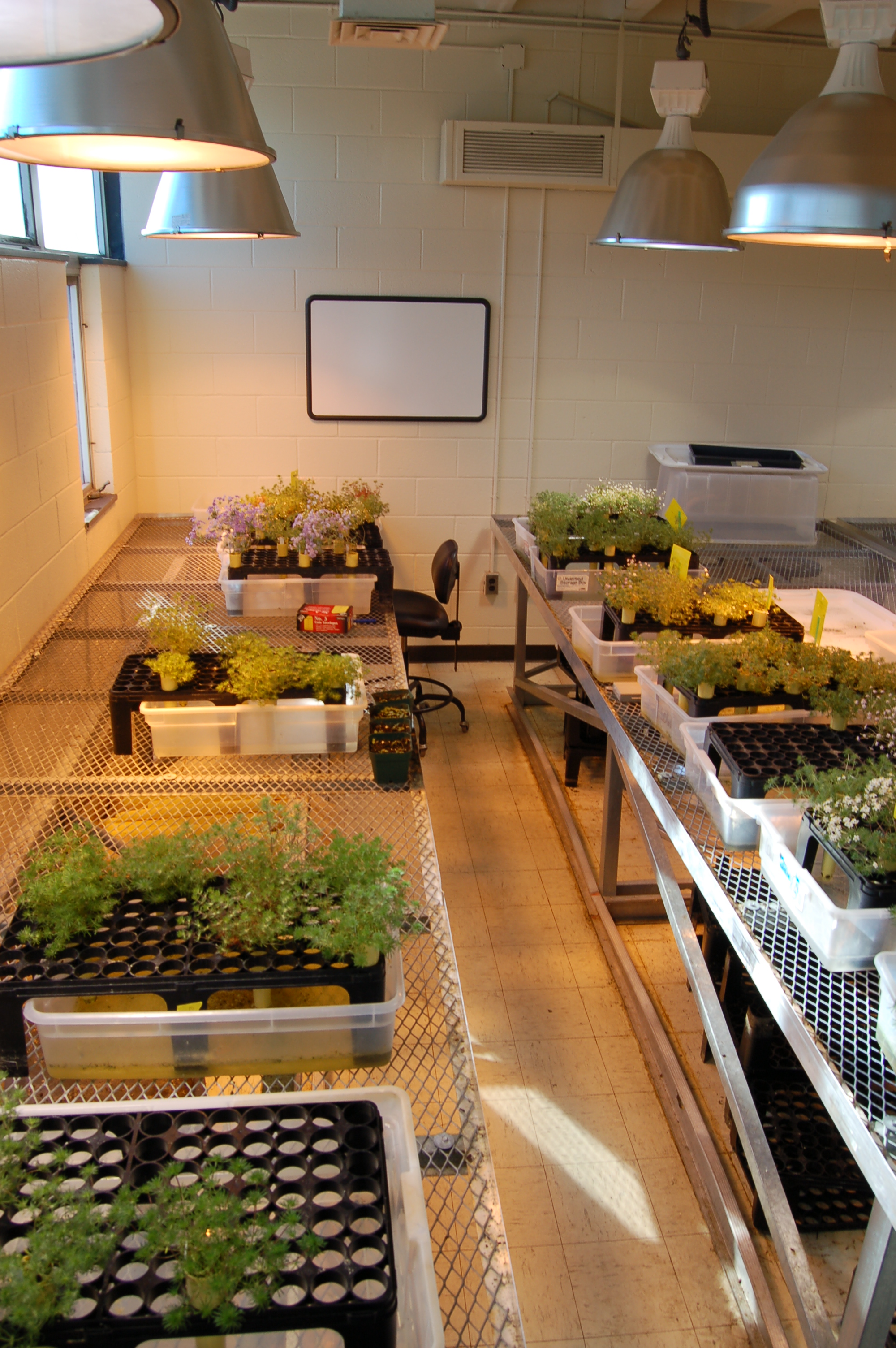
Hybridization
and Plant Breeding Systems. Our work has also focused on the complex
interactions between breeding systems and hybridization and their evolutionary
consequences. Self-incompatible plants appear to have a greater ability
to screen out foreign pollen than self-compatible species. On the other
hand, self-fertilization can strengthen reproductive isolation between species.
We are investigating these and other factors in a study of two species of Leptosiphon that
co-occur in California.
Cleistogamy
in Triodanis.
In recent work, I have begun to develop two species in the genus Triodanis
(Venus’ looking glass) as a study system for evolutionary questions on
cleistogamy. Cleistogamy refers to the production of modified flowers that do
not open and therefore produce seeds solely by self-fertilization. Triodanis
is a genus of widespread weedy annual species. Two species of Triodanis
in North Carolina (T. perfoliata and T. biflora) present
opportunities for investigations into this phenomenon and its evolutionary
implications.
Long-term Ecological Studies of a Wetland
Plant Community.
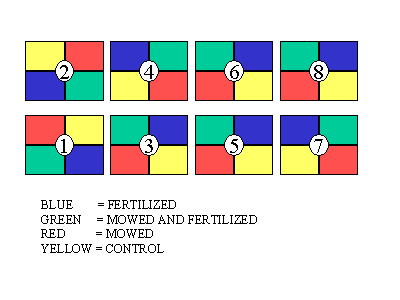 | Experiment
history and design.
We are studying the long-term effects of nutrient addition and disturbance on a
plant community at a site near the ECU campus. In seven years of study,
we have observed significant decreases in diversity in fertilized and unmowed
plots, and changes in the relative abundance of forbs, grasses and woody
species. Initiated with NSF funding, this project involves undergraduate
biology students in authentic ecological research at realistic spatial and
temporal scales. The project has also yielded a Masters thesis. | 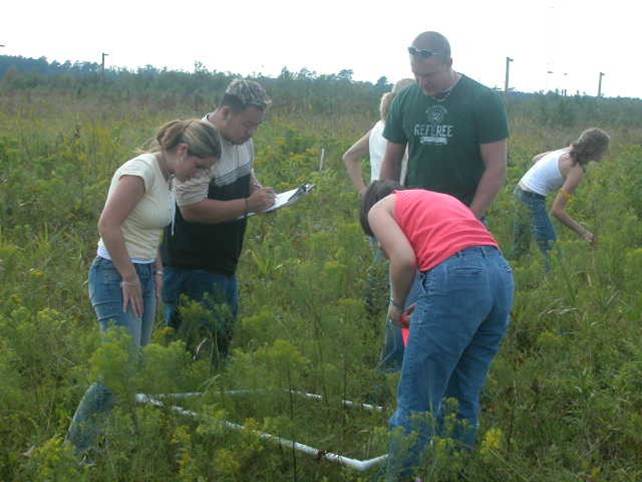 |
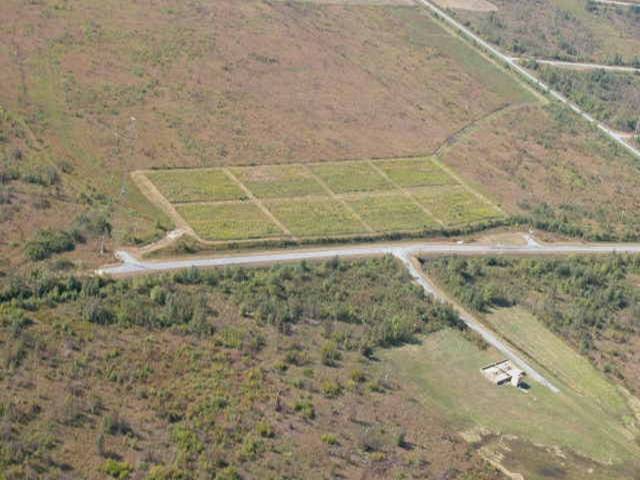 | Evolution
in ecological time.
With new funding from NSF, we are developing tools to test for adaptive
evolution and changes in population genetic structure in response to the
experimental treatments. We are generating AFLP genetic markers and
developing greenhouse cultivation methods for 4-5 target plant species that are
present throughout the long-term ecology plots, including Euthamia
caroliniana (slender goldentop) and Packera tomentosus (woolly
ragwort).
Soil
microbial community.
In collaboration with Dr. Matt Schrenk (ECU) we are extending the project to
explore the effects of treatments on the soil microbial community.
Fertilizer and mowing treatments might affect soil communities either directly,
or indirectly through differences in plant community composition. In
turn, changes in soil microbes community might affect plant growth. Using
an environmental PCR approach to identify microbial species present, we have
found preliminary evidence for dramatic differences in community diversity and
composition in fertilized vs. unfertilized plots. |
 Evolution
of self-compatibility in Leptosiphon. We are interested
in the ecological and genetic factors that play a role in the evolution of
self-fertilization from self-incompatibility – a genetic mechanism that allows
a plant to recognize and reject its own pollen to promote
cross-fertilization. Our research has focused on Leptosiphon, a genus
of California annuals that exhibits remarkable variation in breeding system
traits. Leptosiphon
jepsonii has an unusual and variable breeding system that provides
us with a unique opportunity to study the breakdown of
self-incompatibility. The flowers of most L. jepsonii plants are initially
self-incompatible, becoming capable of selfing later in anthesis; other plants
are self-compatible when flowers first open. The frequency of these
different phenotypes ranges widely among populations, allowing us to explore
how outcrossing rate, inbreeding depression, reproductive assurance and other
parameters are correlated with variation in self-compatibility.
Interestingly, our crossing and selection studies show that different genes
control the timing of self-compatibility in different populations, suggesting
that there are multiple genetic pathways to the breakdown of
self-incompatibility. This project has been funded by NSF and has yielded
two Master's theses.
Evolution
of self-compatibility in Leptosiphon. We are interested
in the ecological and genetic factors that play a role in the evolution of
self-fertilization from self-incompatibility – a genetic mechanism that allows
a plant to recognize and reject its own pollen to promote
cross-fertilization. Our research has focused on Leptosiphon, a genus
of California annuals that exhibits remarkable variation in breeding system
traits. Leptosiphon
jepsonii has an unusual and variable breeding system that provides
us with a unique opportunity to study the breakdown of
self-incompatibility. The flowers of most L. jepsonii plants are initially
self-incompatible, becoming capable of selfing later in anthesis; other plants
are self-compatible when flowers first open. The frequency of these
different phenotypes ranges widely among populations, allowing us to explore
how outcrossing rate, inbreeding depression, reproductive assurance and other
parameters are correlated with variation in self-compatibility.
Interestingly, our crossing and selection studies show that different genes
control the timing of self-compatibility in different populations, suggesting
that there are multiple genetic pathways to the breakdown of
self-incompatibility. This project has been funded by NSF and has yielded
two Master's theses.


